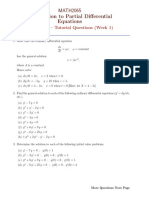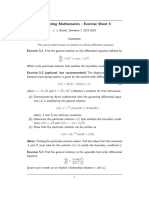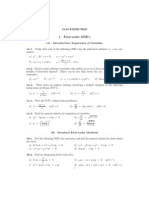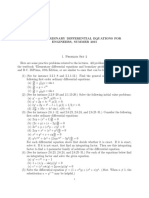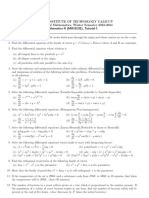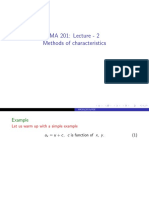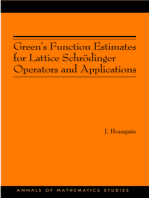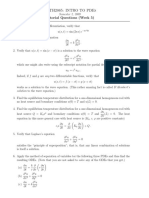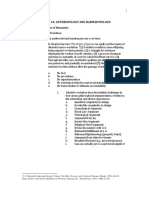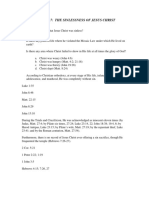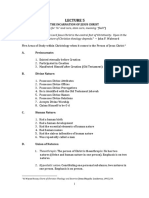Math2065: Intro To Pdes Tutorial Questions (Week 1)
Math2065: Intro To Pdes Tutorial Questions (Week 1)
Uploaded by
TOM DAVISCopyright:
Available Formats
Math2065: Intro To Pdes Tutorial Questions (Week 1)
Math2065: Intro To Pdes Tutorial Questions (Week 1)
Uploaded by
TOM DAVISOriginal Title
Copyright
Available Formats
Share this document
Did you find this document useful?
Is this content inappropriate?
Copyright:
Available Formats
Math2065: Intro To Pdes Tutorial Questions (Week 1)
Math2065: Intro To Pdes Tutorial Questions (Week 1)
Uploaded by
TOM DAVISCopyright:
Available Formats
MATH2065: INTRO TO PDEs
Semester 2, 2009
Tutorial Questions (Week 1)
1. Show that the ordinary differential equation
dx
= µx, µ = constant
dt
has the general solution
x = A eµt ,
where A is a constant.
Hence solve
(a) dx/dt = 3x, x = 2 when t = 0.
(b) dy/dz = −5y, y = 10 when z = 1.
(c) dx/dt = 4 − 3x, x = 0 when t = 0.[Hint: let X = 4 − 3x]
2. Find the general solution to each of the following ordinary differential equations (y 0 = dy/dx,
etc.)
(a) y0 − 7 y = 0
(b) y 00 + y 0 − 2 y = 0
(c) y 00 − 3 y 0 = 0
(d) y 00 − 4 y = 0
(e) y 00 + 4 y = 0
(f) y 00 + 6 y 0 + 9 y = 0
(g) y 00 − 6 y 0 + 25 y = 0
(h) † y 000 + 2 y 00 − y 0 − 2 y = 0
3. Determine the solution to each of the following initial value problems.
(a) y 0 − 7 y = 0 ; y(0) = 1
(b) y 00 − 3 y 0 = 0 ; y(0) = 0 , y 0 (0) = 1
(c) y 00 + 6 y 0 + 9 y = 0 ; y(0) = 0 , y 0 (0) = 1
(d) y 00 − 6 y 0 + 25 y = 0 ; y(0) = 0 , y 0 (0) = 4
4. Verify that y1 (t) = t3 and y2 (t) = t3 ln t both satisfy the differential equation
t2 y 00 − 5 t y 0 + 9 y = 0
in the domain {t > 0}. Hence, make a guess at the general solution to this second-order
linear ordinary differential equation.
5. (a) Write down the definitions for the functions cosh x and sinh x in terms of exponential
functions. Sketch these functions.
(b) Consider the expression y(x) = C1 epx + C2 e−px for some constant p, and suppose C1
and C2 are arbitrary constants. Show that this can be written alternatively as
y(x) = D1 cosh px + D2 sinh px
where D1 and D2 are arbitrary constants.
You might also like
- Olver PDE Student Solutions ManualDocument63 pagesOlver PDE Student Solutions ManualKhaled Tamimy50% (2)
- MATH2065 Introduction To Partial Differential Equations: Semester 2 - Tutorial Questions (Week 1)Document2 pagesMATH2065 Introduction To Partial Differential Equations: Semester 2 - Tutorial Questions (Week 1)Quazar001No ratings yet
- Exercise Sheet 05 2Document7 pagesExercise Sheet 05 2timoiivulaNo ratings yet
- 1 ExDocument7 pages1 Exvennela sainathNo ratings yet
- Assignment SetA 1Document3 pagesAssignment SetA 1Saikat DuariNo ratings yet
- ODE ExerciceDocument12 pagesODE ExerciceMoise RobertoNo ratings yet
- Math2065: Intro To Pdes Tutorial Questions (Week 2)Document1 pageMath2065: Intro To Pdes Tutorial Questions (Week 2)TOM DAVISNo ratings yet
- Tutorial 2 de 2024Document3 pagesTutorial 2 de 2024dlaminisphesihle455No ratings yet
- Instructor: Dr. J. C. Kalita and Dr. Shubhamay SahaDocument3 pagesInstructor: Dr. J. C. Kalita and Dr. Shubhamay SahaMichael CorleoneNo ratings yet
- Tutorial Sheet One-1Document3 pagesTutorial Sheet One-1iddi5504No ratings yet
- Indian Institute of Technology Mandi, H. P. India Engineering Mathematics - IC 110 Tutorial-8 Odd Semester (2019-20)Document1 pageIndian Institute of Technology Mandi, H. P. India Engineering Mathematics - IC 110 Tutorial-8 Odd Semester (2019-20)Amit ProNo ratings yet
- MATH263 ProblemSet2Document2 pagesMATH263 ProblemSet2Daniel DicksonNo ratings yet
- Lecture2 ODEDocument16 pagesLecture2 ODEhoungjunhong03No ratings yet
- ODE 2023 Tutorial 1 and 2Document2 pagesODE 2023 Tutorial 1 and 2Just EntertainmentNo ratings yet
- Mathematical Methods - Assignment 3: Deadline - 5th DecemberDocument2 pagesMathematical Methods - Assignment 3: Deadline - 5th DecemberJAGANNATH RANANo ratings yet
- Math 280 Final Guide (2019) - SmithDocument9 pagesMath 280 Final Guide (2019) - SmithzaneNo ratings yet
- Compre (2017)Document2 pagesCompre (2017)f20221235No ratings yet
- Ma102 OdeDocument2 pagesMa102 OdedundikuladeepeswarNo ratings yet
- Mathematical Tripos Part IA: Complete Answers Are Preferred To FragmentsDocument9 pagesMathematical Tripos Part IA: Complete Answers Are Preferred To FragmentsKrishna OochitNo ratings yet
- Exercises of Chapter 3Document2 pagesExercises of Chapter 3Anh Tuấn PhanNo ratings yet
- Practice Problems For MATH/MTHE 232: April 3, 2014Document5 pagesPractice Problems For MATH/MTHE 232: April 3, 2014Ken PolicarpioNo ratings yet
- Diff Eq FormulasDocument10 pagesDiff Eq Formulasroi_marketingNo ratings yet
- Tutorial Sheet Two-2 092724Document3 pagesTutorial Sheet Two-2 092724iddi5504No ratings yet
- DifferentialDocument5 pagesDifferentialyadavaadityawardhanNo ratings yet
- Tutorial 1Document3 pagesTutorial 1jakharviru009No ratings yet
- 7 On Partial Differential EquationsDocument7 pages7 On Partial Differential EquationsShreyaSharmaNo ratings yet
- Ps 13 SolDocument12 pagesPs 13 SolAngelo OppioNo ratings yet
- First OrderDocument113 pagesFirst Orderaadelaide083No ratings yet
- Advanced Mathematics Exercises: 9 de Septiembre de 2016Document3 pagesAdvanced Mathematics Exercises: 9 de Septiembre de 2016RaulNo ratings yet
- Tutorial 7 PDFDocument2 pagesTutorial 7 PDFAkhil SoniNo ratings yet
- Xy 2 Xyz XTT 2x+3tDocument2 pagesXy 2 Xyz XTT 2x+3tSketchily SebenteNo ratings yet
- Ordinary Differential Equations1Document36 pagesOrdinary Differential Equations1helsonrutinakiNo ratings yet
- MAS 201 Spring 2021 (CD) Differential Equations and ApplicationsDocument23 pagesMAS 201 Spring 2021 (CD) Differential Equations and ApplicationsBlue horseNo ratings yet
- Homework 5 Problem 1Document4 pagesHomework 5 Problem 1沈智恩No ratings yet
- 205 Quiz 3 Solutions Spr12Document3 pages205 Quiz 3 Solutions Spr12ichigosenseiNo ratings yet
- Paperia 2 2023-2Document7 pagesPaperia 2 2023-2ayanoaishi1980No ratings yet
- Tutorial 1Document6 pagesTutorial 1Ashutosh DhamaleNo ratings yet
- MA-108 Ordinary Differential Equations: M.K. KeshariDocument29 pagesMA-108 Ordinary Differential Equations: M.K. KeshariRam RamNo ratings yet
- TutorialDocument3 pagesTutorialmrx9r49nbyNo ratings yet
- Ordinary Differential Equations (Odes) : Department of Mathematics Iit Guwahati Ra/Rks/Mgpp/KvkDocument16 pagesOrdinary Differential Equations (Odes) : Department of Mathematics Iit Guwahati Ra/Rks/Mgpp/KvkNeil MathersNo ratings yet
- Answers To Final-2021Document9 pagesAnswers To Final-2021Enes ErtenNo ratings yet
- Homework8.2 - Ans Diferencial EquationDocument5 pagesHomework8.2 - Ans Diferencial EquationYVES GARNARD IRILANNo ratings yet
- Assignment 1Document2 pagesAssignment 1Vikas RajpootNo ratings yet
- Ma9214-Applied Mathematics For Engineering Design-R8Document3 pagesMa9214-Applied Mathematics For Engineering Design-R8sivagamipalaniNo ratings yet
- Tutorial 5Document1 pageTutorial 5ranaaditay783No ratings yet
- 20085328Document7 pages20085328Lusako MwaijandeNo ratings yet
- Tutorial 4Document2 pagesTutorial 4ranaaditay783No ratings yet
- Week 8 - Practical Exercise Set 2Document1 pageWeek 8 - Practical Exercise Set 2amandhitmarasingheNo ratings yet
- Elimination of Arbitrary ConstantDocument3 pagesElimination of Arbitrary ConstantJomar Del BarrioNo ratings yet
- Ex 2Document2 pagesEx 2farsamuels183No ratings yet
- MA 201: Lecture - 2 Methods of CharacteristicsDocument24 pagesMA 201: Lecture - 2 Methods of CharacteristicsRakshitTiwariNo ratings yet
- 1803Document254 pages1803dinhanhminhqtNo ratings yet
- TBVP Unit3Document64 pagesTBVP Unit3dharanidec15No ratings yet
- MA3220 AY08-09 Sem1Document3 pagesMA3220 AY08-09 Sem1paperforfreeNo ratings yet
- B.SC BA Mathematics Dif DwM8TxZDocument2 pagesB.SC BA Mathematics Dif DwM8TxZsemwalmuskan2005No ratings yet
- Ma147 QS7Document3 pagesMa147 QS7kacperytvidsNo ratings yet
- Mathematics 1St First Order Linear Differential Equations 2Nd Second Order Linear Differential Equations Laplace Fourier Bessel MathematicsFrom EverandMathematics 1St First Order Linear Differential Equations 2Nd Second Order Linear Differential Equations Laplace Fourier Bessel MathematicsNo ratings yet
- Green's Function Estimates for Lattice Schrödinger Operators and ApplicationsFrom EverandGreen's Function Estimates for Lattice Schrödinger Operators and ApplicationsNo ratings yet
- MATH3968 Lecture 2: DR Emma Carberry 29 July 2009Document5 pagesMATH3968 Lecture 2: DR Emma Carberry 29 July 2009TOM DAVISNo ratings yet
- Solutions To Tutorial 5 (Week 6) : Lecturers: Daniel Daners and James ParkinsonDocument12 pagesSolutions To Tutorial 5 (Week 6) : Lecturers: Daniel Daners and James ParkinsonTOM DAVISNo ratings yet
- Solutions To Tutorial 2 (Week 3) : Lecturers: Daniel Daners and James ParkinsonDocument9 pagesSolutions To Tutorial 2 (Week 3) : Lecturers: Daniel Daners and James ParkinsonTOM DAVISNo ratings yet
- MATH3968 Lecture 4: DR Emma Carberry 4 August 2009Document4 pagesMATH3968 Lecture 4: DR Emma Carberry 4 August 2009TOM DAVISNo ratings yet
- Math2065: Intro To Pdes Tutorial Questions (Week 6)Document1 pageMath2065: Intro To Pdes Tutorial Questions (Week 6)TOM DAVISNo ratings yet
- Math2065: Intro To Pdes Tutorial Solutions (Week 7)Document4 pagesMath2065: Intro To Pdes Tutorial Solutions (Week 7)TOM DAVISNo ratings yet
- MATH3968 Lecture 1: DR Emma Carberry 28 July 2009Document5 pagesMATH3968 Lecture 1: DR Emma Carberry 28 July 2009TOM DAVISNo ratings yet
- Solutions To Tutorial 1 (Week 2) : Lecturers: Daniel Daners and James ParkinsonDocument11 pagesSolutions To Tutorial 1 (Week 2) : Lecturers: Daniel Daners and James ParkinsonTOM DAVISNo ratings yet
- Math2065: Intro To PdesDocument1 pageMath2065: Intro To PdesTOM DAVISNo ratings yet
- Math2065: Intro To Pdes Tutorial Solutions (Week 6)Document4 pagesMath2065: Intro To Pdes Tutorial Solutions (Week 6)TOM DAVISNo ratings yet
- MATH3968 Lecture 3: DR Emma Carberry 30 July 2009Document3 pagesMATH3968 Lecture 3: DR Emma Carberry 30 July 2009TOM DAVISNo ratings yet
- Math2065: Intro To Pdes Tutorial Questions (Week 4)Document2 pagesMath2065: Intro To Pdes Tutorial Questions (Week 4)TOM DAVISNo ratings yet
- Math2065: Intro To Pdes Tutorial Questions (Week 5)Document1 pageMath2065: Intro To Pdes Tutorial Questions (Week 5)TOM DAVISNo ratings yet
- THS 540 Module 1 Session I-VII-2005 1 - 1Document56 pagesTHS 540 Module 1 Session I-VII-2005 1 - 1Ginboi Khongsai100% (1)
- Math2065: Intro To Pdes Tutorial Solutions (Week 4)Document5 pagesMath2065: Intro To Pdes Tutorial Solutions (Week 4)TOM DAVISNo ratings yet
- Math2065: Intro To Pdes Tutorial Questions (Week 3)Document1 pageMath2065: Intro To Pdes Tutorial Questions (Week 3)TOM DAVISNo ratings yet
- Math2065: Intro To Pdes Tutorial Solutions (Week 3)Document3 pagesMath2065: Intro To Pdes Tutorial Solutions (Week 3)TOM DAVISNo ratings yet
- Math2065: Intro To Pdes Tutorial Questions (Week 2)Document1 pageMath2065: Intro To Pdes Tutorial Questions (Week 2)TOM DAVISNo ratings yet
- Math2065: Intro To Pdes Tutorial Solutions (Week 2)Document4 pagesMath2065: Intro To Pdes Tutorial Solutions (Week 2)TOM DAVISNo ratings yet
- Guide For The PerplexedDocument2 pagesGuide For The PerplexedTOM DAVISNo ratings yet
- Math2065: Intro To Pdes Tutorial Solutions (Week 1) : 3t 5 (1 Z) 3t 3t 4 3 3tDocument3 pagesMath2065: Intro To Pdes Tutorial Solutions (Week 1) : 3t 5 (1 Z) 3t 3t 4 3 3tTOM DAVISNo ratings yet
- Week One: Foundations of Old Testament TheologyDocument9 pagesWeek One: Foundations of Old Testament TheologyTOM DAVISNo ratings yet
- Lecture 10 Christianity Major Terms and Positions and EschatologyDocument43 pagesLecture 10 Christianity Major Terms and Positions and EschatologyTOM DAVISNo ratings yet
- Lecture 10: Anthropology and Harmartiology:: Views of Creation of HumanityDocument15 pagesLecture 10: Anthropology and Harmartiology:: Views of Creation of HumanityTOM DAVISNo ratings yet
- Bvpfourier PDFDocument1 pageBvpfourier PDFTOM DAVISNo ratings yet
- Lecture 7 Christianity Sinlessness of Jesus ChristDocument4 pagesLecture 7 Christianity Sinlessness of Jesus ChristTOM DAVISNo ratings yet
- Lecture 5 Christianity Person of Jesus ChristDocument8 pagesLecture 5 Christianity Person of Jesus ChristTOM DAVISNo ratings yet
- A Closer Look at Worldview ThinkingDocument9 pagesA Closer Look at Worldview ThinkingTOM DAVISNo ratings yet
- Lecture 6 Christianity KenosisDocument4 pagesLecture 6 Christianity KenosisTOM DAVISNo ratings yet
- Lecture 2 Origin of ManDocument3 pagesLecture 2 Origin of ManTOM DAVISNo ratings yet

